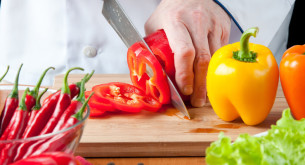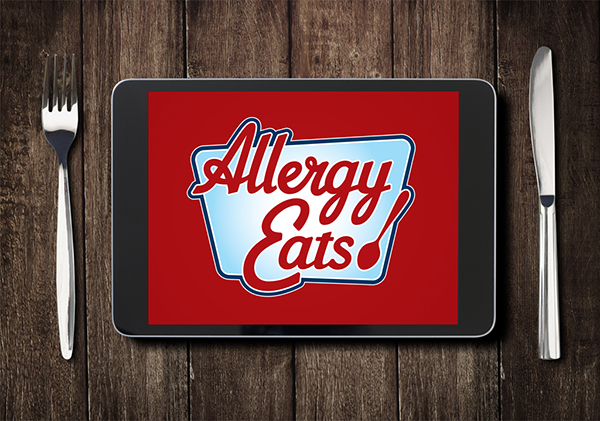From The Chef
When dining out with food allergies, are we asking the right questions and communicating clearly with restaurant staff? We spoke to several chefs to hear their perspective on what food-allergic diners could do to foster a more comfortable dining experience.
Chef Tips for Dining Out with Food Allergies:
- Do Your Homework. Before visiting a restaurant, look at their online menu so you have a better idea of the types of food available there. If you understand the type of cuisine and possible ingredients that could be on-hand, you’ll be better prepared to brainstorm meal ideas with the restaurant’s staff. For instance, you might see mashed potatoes on the menu but if your dairy allergy precludes you from eating them, consider asking if they could make you a baked potato instead. Sometimes an idea that’s obvious to you may not be something that the staff would necessarily consider, so speak up! Some chains offer interactive menus that show which items are allergen-free. Remember – even if you’ve looked at a restaurant’s menu and allergen information online in advance, you still must speak to the staff about your allergies in person, every time!
- Recognize Menu Items May Be More Complex than They Appear. While a dish may appear to be quite simple on the menu, it could actually contain a variety of components, such as marinades, breadings and sauces, so ask detailed questions about how each dish is prepared. If, for example, you’re allergic to garlic, a widely-used ingredient in marinades and salad dressings, realize that these items are often prepared hours before service begins. Similarly, poultry and beef dishes often contain marinades that include milk, soy sauce, Worcestershire, and other items that contain common allergens (e.g., dairy, soy and fish). If you call in advance and explain your allergies, the chef can set aside some plain (non-marinated) ingredients and/or custom-make a salad dressing without your allergens. Keep in mind that chefs pride themselves on signature dishes and techniques, so by inquiring in advance, you allow them the opportunity to use their creativity to customize dishes that meet your needs.

- Consider the Busiest Times and Days for a Restaurant – And Try NOT to Dine Then. Just like a busy mom or dad knows that the time between after school and bedtime is often extremely busy and chaotic due to juggling homework, after-school activities, and cooking dinner, chefs have similar times of day and week when the restaurant is pure mayhem! When the kitchen is less busy (e.g., not on a Saturday night at 7 pm), restaurant staff will likely take more time to communicate with you about your allergies, and then will be better able to take the proper precautions with your order. So, when possible, consider dining at those off-peak times.
- Communicate Your Food Allergy or Intolerance. As obvious as that sounds, in a recent study of 106 food-allergic people, 45% didn’t communicate their food allergies to restaurant staff, according to Dr. Scott H. Sicherer of Mt. Sinai Hospital in New York. If the servers and chefs aren’t aware of your allergies, they won’t know to accommodate them and cross-contact becomes a much more serious risk! Even if you have comfortably eaten at that establishment before, it’s critical to remind the servers of your allergies and ask if any ingredients or kitchen protocols have changed since your last visit.
- Understand the Restaurant’s Food Allergy Protocols. When dining out, food allergic diners often have some trepidation, and want to engage in dialogue about the restaurant’s food allergy procedures and protocols. If you are not able to call in advance, your first step should be to ask either the hostess or server if they have a “point person” for food allergies and, if so, if you can speak to them. Many restaurants have processes built in and it can save everyone time by simply asking up front who is best able to help you.
- Use a Chef Card. Listing your allergies and intolerances on a chef card (or purchasing some online) helps clearly communicate which foods you cannot tolerate, and is very useful for restaurant staff. This is especially important for diners that have multiple, extensive, and/or unusual allergies. Some of the more elaborate chef cards list many “hidden” names for each allergen, and help ensure that none of those ingredients are used to create meals for those diners.
- Know Your Own Allergy. You should know the “aliases” for your allergens. Recognize, for instance, that the ingredients casein and whey are dairy and semolina is wheat. Make sure that your servers and chefs are aware of your allergies, as well as their aliases, so they can confirm that none of these items are used in your meal (again, this is where a chef card may be helpful). Also realize that your allergens could be “hidden” in unexpected places. Nuts can be in breads and even simple desserts. Egg can be in breads, pasta and ice cream. Blue cheese contains gluten. Soy can be in practically anything.
- Labels are Not Always Available for Customers to Read. The food allergy community must be diligent about reading labels all the time, and it can be difficult to “give up” that task at restaurants, entrusting their staff to do this important job without you. It’s always reassuring to read labels yourself, but, unfortunately, restaurants sometimes buy items from outside bakeries or order from vendors that don’t include ingredient lists. If a server, chef or manager says the label is unavailable, they’re not trying to be difficult. If they can’t disclose exactly what’s in a bakery item – or in a prepackaged sauce – they’ll often suggest substitutions that they know are free of guests’ allergens.
- Trust Your Instincts. Some restaurants use different colored (or shaped) plates or baskets to serve allergy-friendly meals. If you know the restaurant always puts food allergy meals on a square plate or uses a purple frill pick to mark special custom-made meals, speak up if your meal arrives without those things. Regardless, confirm that your meal is the allergy-friendly one when it arrives at your table, especially if something seems “off”. If the bun looks buttered and you have a dairy allergy, politely call the server over to double-check. Or if your plate is drizzled with something that you suspect might be pesto and you have a nut allergy, don’t eat anything until you speak with the server, manager or chef about it.
- Always Carry Your Epinephrine and Any Other Allergy Medication. We can’t emphasize enough how important it is to bring your allergy medication (e.g., epinephrine or antihistamine) everywhere you go. No restaurant can guarantee that they can serve a completely safe meal 100% of the time. Mistakes happen, so always be prepared.
- Help the Entire Community by Sharing Your Experience. Whether you dine out and have a great (or not-so-great) experience, share that information on AllergyEats so that the rest of the food-allergy community learns from your experience. Restaurants that make the effort to more confidently accommodate you will certainly appreciate your review.

